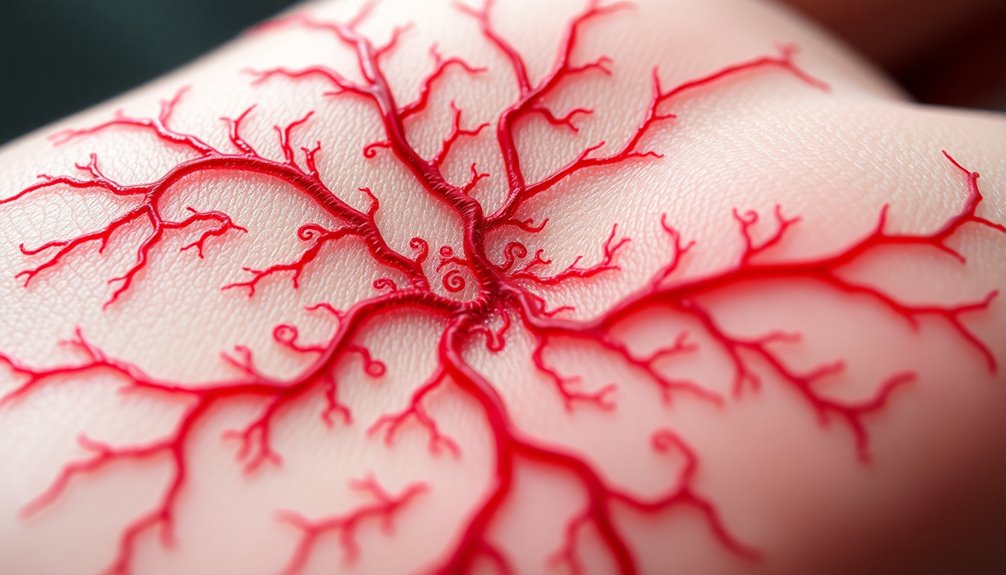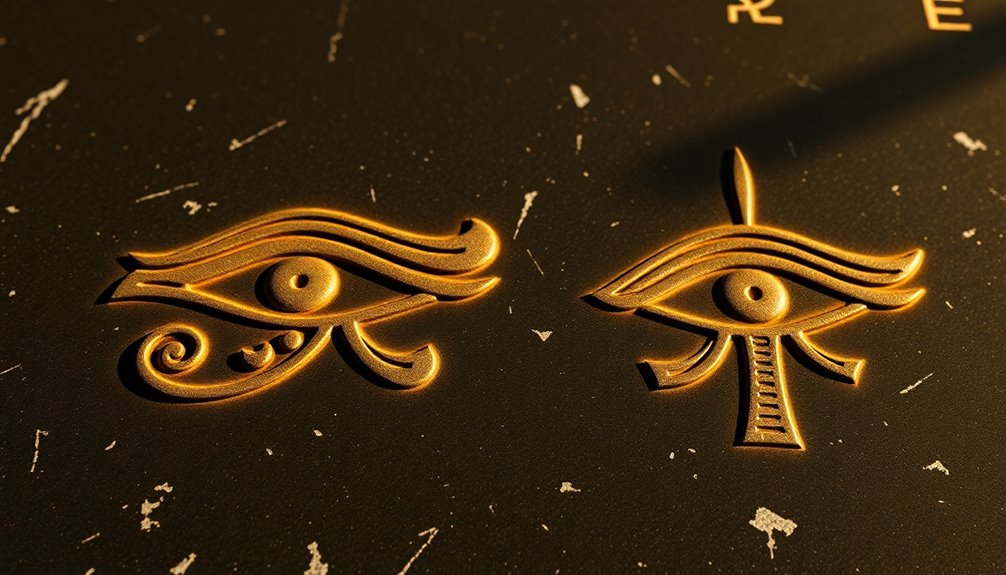The scarab beetle is more than just a fascinating insect; it's a potent symbol of transformation and renewal. In ancient Egypt, it represented the sun god Khepri, linking to rebirth and the cycles of life. As a protective emblem, scarabs were often placed on the heart during mummification to guarantee good fortune in the afterlife. Beyond history, they inspire creativity, reminding you that new beginnings often emerge from endings. Engaging with the scarab's symbolism can foster personal growth and community connections. Discover how this marvelous symbol continues to resonate in modern culture and your personal life.
Key Takeaways
- The scarab symbolizes transformation and renewal, embodying the cycle of life, death, and rebirth in various spiritual contexts.
- In ancient Egypt, scarabs represented protection, serving as amulets for safe passage to the afterlife and ensuring good fortune.
- Scarab imagery inspires creativity, encouraging individuals to explore new forms of expression and embrace personal growth through transformative experiences.
- The intricate designs of scarabs in art reflect wealth and cultural significance, linking past beliefs to contemporary spiritual practices and aesthetics.
- Engaging with scarab symbolism fosters community connections, promoting shared experiences and collective exploration of spirituality and creativity.
Historical Significance of Scarab Beetles
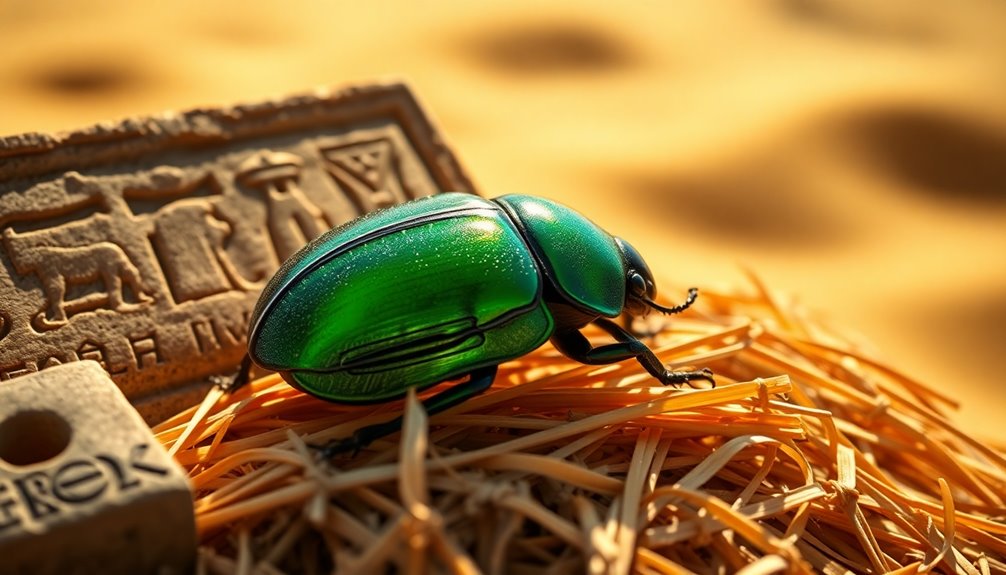
The scarab beetle, often seen as a symbol of transformation, held immense historical significance in ancient Egypt. Revered as a representation of the sun god Khepri, the scarab embodied creation and regeneration. Its artifacts, dating back to the Old Kingdom (c. 2686–2181 BCE), were frequently discovered in tombs, reflecting the ancient Egyptians' deep beliefs in the afterlife and the safe passage of the deceased.
You might be surprised to learn that scarabs also served practical purposes. They were commonly used as seals for documents, signifying authority and power. Many were inscribed with personal names and religious symbols, emphasizing their importance in both daily life and spiritual practices.
One notable example is the iconic Scarab of Hatshepsut, a large gold artifact adorned with precious stones, showcasing the wealth and craftsmanship of ancient Egyptian society while symbolizing the power of one of its most prominent female pharaohs.
Additionally, scarab amulets were placed on the heart during mummification, acting as protective symbols against evil. These practices highlight the scarab's essential role in ancient Egyptian culture and the profound beliefs surrounding life, death, and resurrection. Furthermore, the scarab's association with creation and regeneration resonates with the broader themes of renewal found in many ancient cultures, illustrating its universal appeal.
Symbolism of Renewal and Transformation
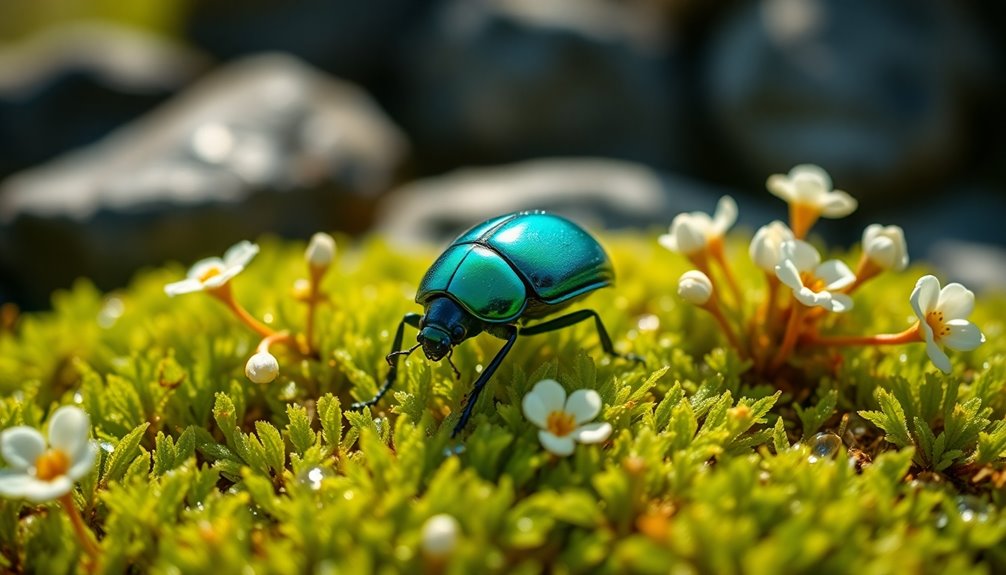
How can a small beetle carry such profound meanings? The scarab beetle became a powerful symbol of renewal and transformation in ancient cultures, particularly in Ancient Egypt. Associated with the sun god Ra, this beetle represented the cycle of life, death, and rebirth. Observing the dung beetle rolling dung balls, people were inspired by its behavior, leading to beliefs in regeneration and the endless cycles of existence.
In ancient Egypt, scarabs weren't just decorative; they served as amulets inscribed with names and wishes, acting as symbols of protection and personal identity. Their popularity across all social classes underscores their significance, reminding everyone of the potential for change and spiritual evolution.
Each scarab you encounter reflects the belief that every ending leads to a new beginning, encapsulating the essence of life's perpetual cycles.
When you embrace the symbolism of the scarab beetle, you're invited to recognize the transformative power inherent in your own life experiences. Whether facing challenges or celebrating triumphs, the scarab beetle encourages you to embrace renewal and transformation, guiding you toward a brighter, more enlightened path.
Artistic Representations of Scarabs
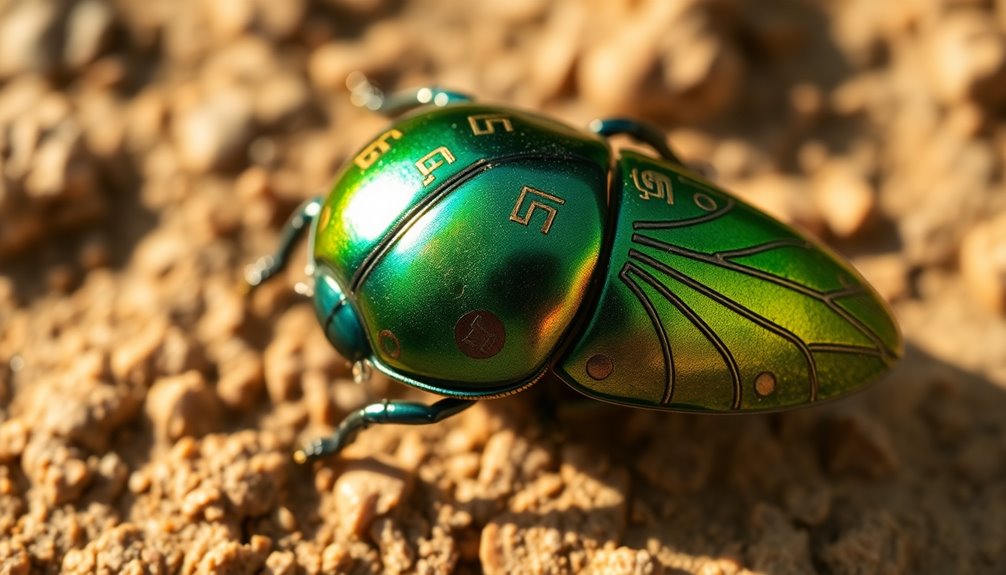
Scarabs captivate with their intricate designs and rich symbolism, making them a staple in ancient Egyptian art. You'll often find scarab beetles depicted in stunning gold and black color schemes, representing wealth and protection. These color choices not only enhance their visual appeal but also signify the cultural importance of these symbols in ancient society.
You may notice that scarab motifs appear across various art forms, from exquisite jewelry to detailed sculptures and vibrant paintings. Each piece showcases the intricate patterns and craftsmanship that define scarab artifacts, reflecting their enduring influence throughout history.
Even in modern times, artists draw inspiration from these ancient designs, merging historical significance with contemporary aesthetics. Scarab imagery has also made its way into tattoo art, where it symbolizes protection, renewal, and the cycle of life.
This blend of ancient meanings with modern expressions highlights the scarab's lasting impact on culture and art.
Scarabs in Funerary Practices
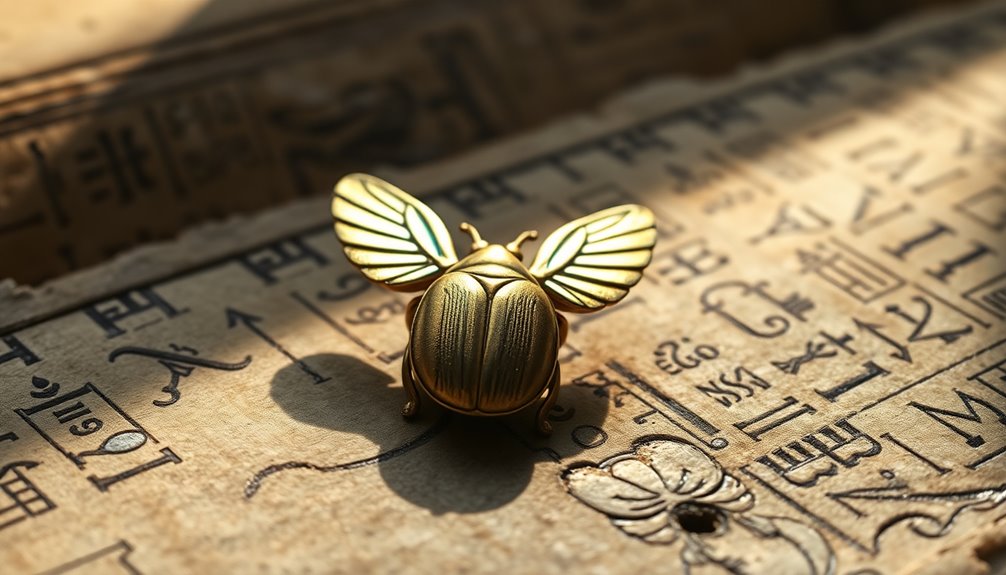
When you explore scarabs in funerary practices, you'll find they serve as powerful amulets meant to guide the deceased safely into the afterlife.
These symbols often represent the heart, which played a vital role in the judgment process during mummification.
Scarabs as Afterlife Amulets
Often regarded as powerful symbols in Ancient Egypt, scarab amulets played an essential role in funerary practices. These sacred symbols were often placed in tombs to protect the deceased and guarantee a safe passage to the afterlife. The scarab, or dung beetle, became a significant representation of rebirth and change, reminding us of the cycle of life, death, and resurrection central to Egyptian religion.
In many cases, scarabs were positioned over the heart during mummification rituals. This act was believed to secure a good luck charm for the spirit on its journey. The Beetle Spirit, revered across cultures around the world, symbolizes not just protection but also the hope for eternal life beyond the grave. Scarab artifacts found in burial sites continue to signify their importance in securing favor with the gods.
As you explore the symbolism of scarabs, consider how they serve as your Spirit Animal, guiding you through changes in life. Just like the ancient Egyptians, you can embrace the spirit of the scarab, rolling your own metaphorical balls of challenges, transforming them into opportunities for growth and renewal.
Heart Symbolism in Mummification
In ancient Egyptian mummification, the heart held immense significance, serving as an important organ in the journey to the afterlife. You'd find scarab amulets, often shaped like the beetle, placed on the deceased's heart. These heart scarabs symbolized protection and were vital for guaranteeing safe passage to the afterlife. The Egyptians believed the heart would be weighed against Ma'at's feather, determining one's fate in the afterlife.
To enhance this protective measure, heart scarabs were inscribed with spells and prayers, designed to safeguard the deceased and grant them good fortune on their journey beyond death. The presence of these amulets in tombs underscores the Egyptians' profound connection to resurrection and eternal life, as they viewed the scarab beetle as a powerful symbol of regeneration.
Additionally, scarab amulets were sometimes crafted from precious materials, reflecting the wealth and status of the deceased, further emphasizing their importance in funerary rituals. By incorporating these beetle-shaped symbols, the ancient Egyptians guaranteed that their loved ones would be protected and guided through the mysteries of the afterlife.
Cultural Impact Across Civilizations

As cultures evolved, the scarab beetle emerged as a powerful symbol across various civilizations, embodying concepts of transformation and protection. In ancient Egypt, it was revered as a representation of rebirth and closely linked to the sun god Ra, illustrating the eternal cycle of life and death.
This deep-rooted symbolism influenced the creation of artifacts, jewelry, and art, where scarab motifs signified protection and good fortune. Beyond Egypt, Native American traditions also recognized the beetle's significance, associating it with both death and prosperity, highlighting its essential role in the natural cycle.
The scarab's cultural impact didn't stop in the past; it continues to resonate today. Its imagery frequently appears in modern tattoos and body art, symbolizing renewal and resilience.
Archaeological discoveries of scarab artifacts, dating back to the Old Kingdom of Egypt, underline their importance in trade and communication. They served as seals for documents, demonstrating their value in ancient societies.
This multifaceted significance of the scarab reflects its enduring legacy, reminding you of the interconnectedness of life, death, and transformation across cultures.
Scarab Beetle Spirit and Creativity
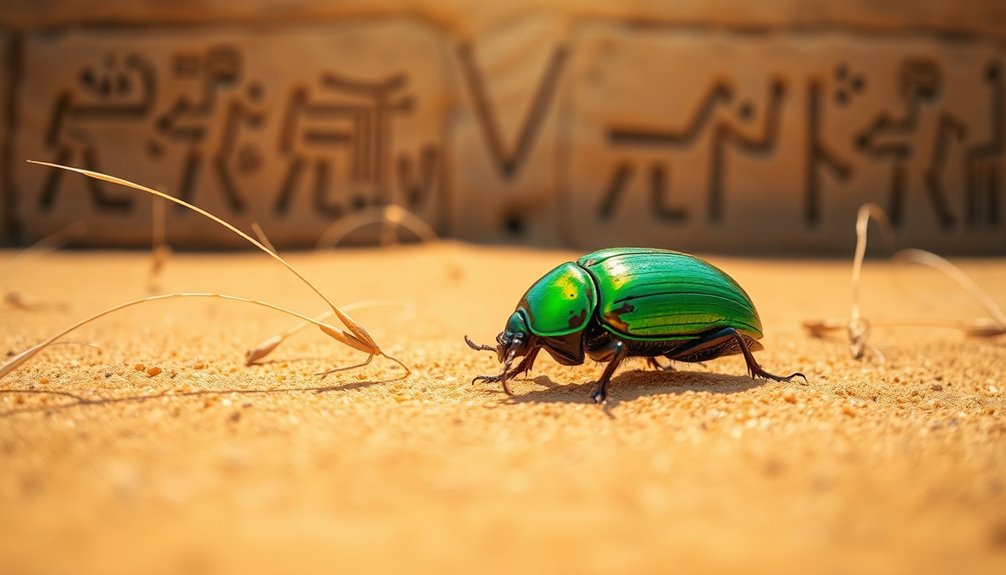
The Scarab Beetle Spirit not only embodies transformation but also serves as a powerful muse for creativity. This spirit inspires you to explore and express your creative impulses in diverse forms.
Just like the scarab's role in ancient Egyptian mythology, it highlights the transformative power of creativity, reminding you that extraordinary outcomes can arise from simple beginnings.
When you embrace the Scarab Beetle Spirit, you tap into your inner wisdom, enhancing your creative energy and potential for success in various endeavors.
This spirit encourages you to break free from routine and venture into unconventional avenues, fostering innovation and resilience in your creative process.
Overcoming Creative Doubts
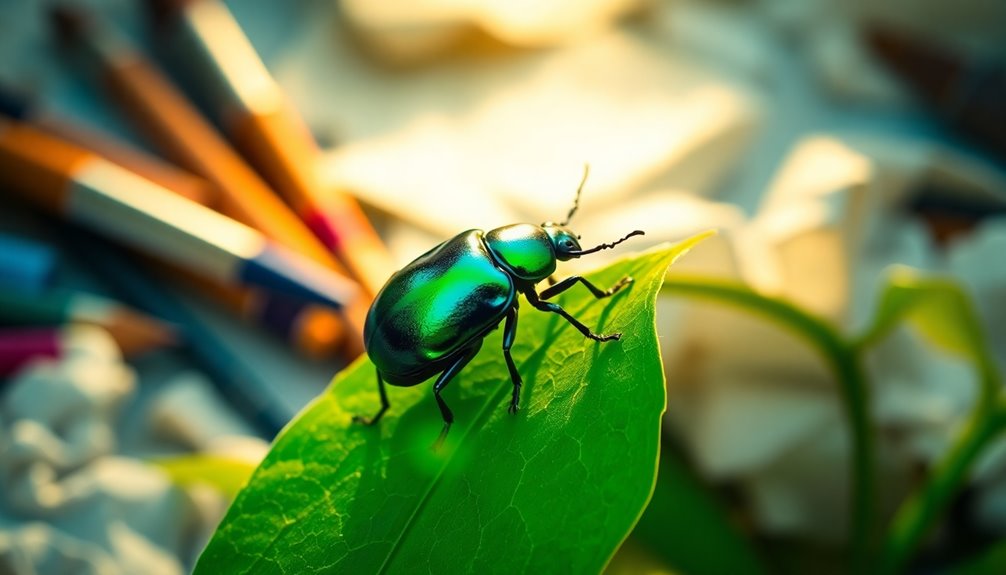
Overcoming creative doubts is a journey many face, but the Scarab Beetle Spirit reminds you that everyone has unique inner magic waiting to be set free. Embrace your creative potential without fear of inadequacy. Remember, resilience and innovation are inherent traits within you, urging you to push past those nagging doubts and explore new creative avenues.
Sometimes you need a break from your routine to rediscover your creative impulses. The Scarab encourages you to step outside your comfort zone and experiment with unconventional methods. Whether it's trying a new medium or simply changing your environment, allow yourself the freedom to nurture your creativity in unexpected ways. Engaging in practices like nighttime meditation can also help clear your mind and inspire fresh ideas.
Acknowledge that creativity is a divine legacy available to all, and see your expression as a natural part of your identity. By dispelling fears of lacking originality, you empower yourself to engage fully in your creative processes. This leads not only to transformative outcomes but also to profound personal growth.
Additionally, many artists find that visualization techniques can significantly enhance their creative flow, allowing them to align with their true artistic vision. Embrace the Scarab's message, and trust that your creativity is a powerful force that deserves to be released. Your unique magic is waiting; all you need to do is take that first step.
Community Engagement and Sharing
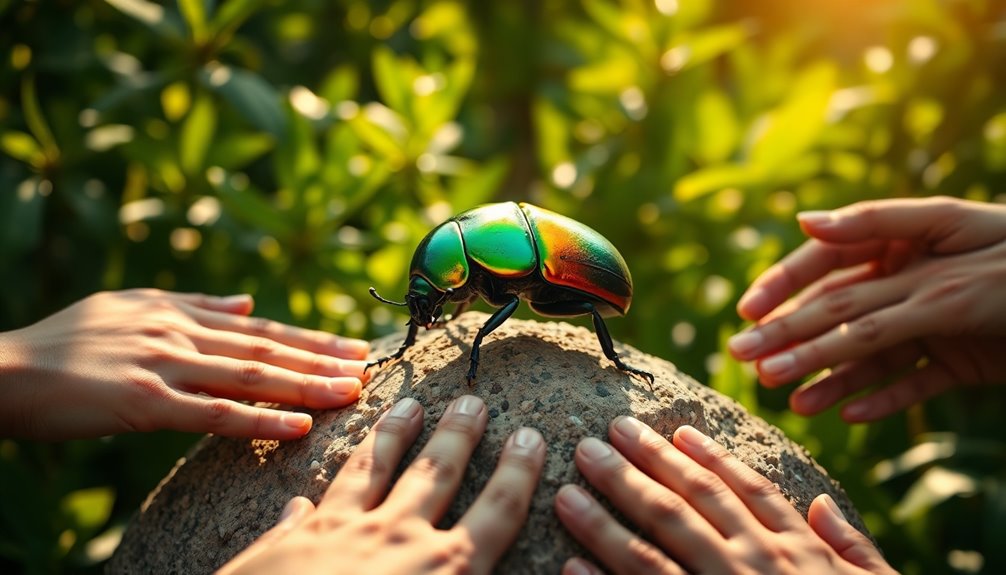
Embracing creativity often leads to a desire for connection with others who share your passions. Engaging with the community around the scarab symbolizes shared experiences and fosters a sense of belonging. By participating in discussions and leaving comments, you deepen these connections. Subscribing to newsletters can further enhance your engagement, offering exclusive insights and special offers.
Social media platforms like Instagram and Facebook are excellent for sharing your scarab-themed artwork and ideas. They allow you to connect with like-minded enthusiasts. Utilizing hashtags related to scarabs boosts your visibility and helps you discover others on the same journey.
Here's a quick overview of ways to engage with the community:
| Activity | Benefit |
|---|---|
| Commenting on posts | Builds connections |
| Subscribing to newsletters | Access to exclusive content |
| Sharing artwork on social media | Encourages participation |
| Using scarab-related hashtags | Increases visibility |
| Attending community events | Promotes collective exploration |
Active participation in these avenues encourages a deeper exploration of personal spirituality and creativity, making your scarab journey even more fulfilling.
Frequently Asked Questions
What Does the Scarab Symbolize Spiritually?
The scarab symbolizes renewal and rebirth in a spiritual sense. It connects you to the cycles of life and the transformative power of creation.
When you embrace the scarab's essence, you acknowledge the importance of personal growth and protection throughout your journey.
This ancient symbol encourages you to let go of the past, embrace change, and trust in the divine guidance that leads you toward a brighter future, embodying the spirit of regeneration.
What Is the Symbol of the Scarab?
The scarab symbolizes rebirth, transformation, and protection. It represents the sun god Ra and embodies the life cycle's endless journey.
When you see a scarab, think of its role in ancient Egyptian culture as a powerful amulet, believed to bring good fortune and safe passage to the afterlife.
The scarab's behavior, rolling dung, inspired beliefs about renewal and the cycle of life, reminding you of personal growth and change.
What Is the Metaphor of the Scarab?
Have you ever wondered how a simple beetle can embody such profound meanings?
The scarab serves as a powerful metaphor for transformation and the cyclical nature of life. It reflects renewal, urging you to embrace change and growth.
As the dung beetle rolls its ball, it symbolizes persistence and the journey of the sun, reminding you that every ending leads to a new beginning.
This connection to life's cycles invites you to reflect on your own experiences.
What God Does the Scarab Represent?
The scarab represents the ancient Egyptian god Khepri, who embodies the rising sun and creation.
When you think about Khepri, envision a figure with a scarab beetle head, symbolizing rebirth and life's cyclical nature.
The scarab's actions, like rolling dung, reflect the sun's journey across the sky, reinforcing its connection to renewal.
This powerful symbolism reminds you of the importance of transformation and protection in both life and the afterlife.
Conclusion
In exploring the scarab's spiritual significance, you've uncovered a powerful symbol of renewal, creativity, and transformation. By embracing its message, you can inspire change, ignite your imagination, and foster community connections. Whether you're overcoming doubts or celebrating creativity, let the scarab guide you. Remember, it's more than just an ancient symbol; it's a reminder that you have the strength to evolve, the courage to create, and the ability to connect with others on your journey.


